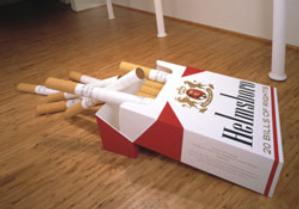Crimes and Misdemeanors / Moshekwa Langa
dal 21/11/2003 al 21/11/2004
Segnalato da
Moshekwa Langa
Ross Bleckner
Karen Finley
Gran Fury
Group Material
Guerilla Girls
Hans Haacke
Keith Haring
Lynn Hershman
Deborah Kass
Mike Kelley
Jeff Koons
Barbara Kruger
Louise Lawler
Sherrie Levine
Robert Longo
Robert Mapplethorpe
Allan McCollum
Richard Prince
Tim Rollins
KOS
Martha Rosler
David Salle
Julian Schnabel
Cindy Sherman
Haim Steinbach
David Wojnarowicz
Krystof Wodiczko
21/11/2003
Crimes and Misdemeanors / Moshekwa Langa
Contemporary Arts Center, Cincinnati
Politics in U.S. Art of the 1980s. Given the fact that the 1980s in the U.S. saw a virtually unprecedented representation of political sentiment in the visual arts, it is worth revisiting the decade in order to offer a carefully constructed social-critical account of artistic production in the period and to explain the relationship of the key representational strategies listed above to the evolution of more politicized artistic practices. Langa left South Africa for Amsterdam three years ago, and his current work explores the poetic aspects of his expatriation

Politics in U.S. Art of the 1980s
Recent historical and critical accounts of U.S. art of the 1980s have tended to focus on theoretical issues in representation, especially appropriation and simulation. But this approach encourages a nearly exclusive focus on the studio products of just a few key artists (Ashley Bickerton, Peter Halley, Jeff Koons, David Salle, Julian Schnabel and Haim Steinbach, to name the most prominent), whose accomplishments are best understood with reference to formalist modernism. These accounts tend to marginalize not only those individuals and collaboratives working outside of the museum-gallery-critic network, but particularly artists with more directly expressed, critical economic, social, and political commitments.
Given the fact that the 1980s in the U.S. saw a virtually unprecedented representation of political sentiment in the visual arts, it is worth revisiting the decade in order to offer a carefully constructed social-critical account of artistic production in the period and to explain the relationship of the key representational strategies listed above to the evolution of more politicized artistic practices. This exhibition is organized around the exploration of four sub-themes: Having/Not, Identity/Constructs, Institutional/Critiques, and Sex/Kills. Each will allow the juxtaposition of now iconic works of art with important but largely non-canonical works that critique or undermine the dominant ideological expressions they represent.
For example, in Having/Not Haim Steinbach's celebration of commodity culture will be juxtaposed with the decidedly anti-capitalist projects of Group Material and the work on homelessness by the Artist and Homeless Collaborative/Hope Sandrow. In Sex/Kills, the graphic and readily available sexuality represented in works by Koons and Richard Prince will be juxtaposed with the AIDS activist agit-prop of Gran Fury and Barbara Kruger's work on feminist theories of the male gaze. And in Identity/Constructs, Neo-Expressionist celebration of the authentic, heroic "self" as represented in the new gestural painting will be juxtaposed with deconstructions of the very notion of authentic selfhood by David Hammons, Cindy Sherman, Carrie Mae Weems and others - particularly the selfhood of non-male, non-white, non-straight, non-privileged people.
The following is a partial list of artists to be represented: Artist and Homeless Collaborative, Ross Bleckner, Karen Finley, Gran Fury, Group Material, Guerilla Girls, Hans Haacke, Keith Haring, Lynn Hershman, Deborah Kass, Mike Kelley, Jeff Koons, Barbara Kruger, Louise Lawler, Sherrie Levine, Robert Longo, Robert Mapplethorpe, Allan McCollum, Richard Prince, Tim Rollins + KOS, Martha Rosler, David Salle, Julian Schnabel, Cindy Sherman, Haim Steinbach, David Wojnarowicz, and Krystof Wodiczko.
-------
Moshekwa Langa
Moshekwa Langa was born in Bakenburg, Potgietersrus, South Africa, in 1975 - more than a decade before the end of apartheid and the unification and democratization of the nation. As a black South African, he not only witnessed but also experienced first hand the injustices of racial segregation; in particular, two decades of forced resettlement of blacks that displaced more than 3.5 million people. This government resettlement program resulted in a mass migration that separated families, disrupted the larger social fabric, and produced numerous impoverished, crime-ridden shantytowns.
Langa left South Africa for Amsterdam three years ago, and his current work explores the poetic aspects of his expatriation. He is a restless scavenger who uses a wide range of materials and media - string, photography, drawing, collage, video, found objects, and painting - to record its impact. His busy installation aesthetic is placed at the service of a critical wit fueled by his personal sense of displacement and alienation.
Incorporating maps, documentary materials, and appropriated texts, Langa's drawings and installation environments are charged with the sentimental voice of the émigré caught between new opportunities and nostalgia, the familiar and the fresh challenge. For the CAC, he will bring together recent videos, photographs, works on paper, and scatter-art pieces that broaden his investigations beyond specifically personal preoccupations to engage larger questions raised by globalization.
Moshekwa Langa was trained at the Rijksakademie voor Beeledende Kunst in Amsterdam. His work has been presented in solo exhibitions at The Renaissance Society in Chicago, the Centre d'Art Contemporain in Geneva, and the Museum Boijmans van Beuningen in Rotterdam.
These exhibitions are organized by the CAC.
Image: Hans Haacke, Helmsboro County 1990, Silkscreen prints and photography on wood, cardboard and paper, 301/2x80x471/2 inches
Contemporary Arts Center
44 East 6th Street Cincinnati, Ohio 45202



